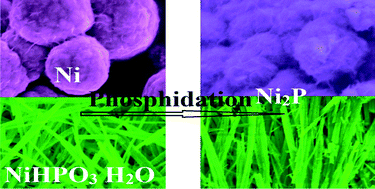Shape-controlled synthesis and performance comparison of Ni2P nanostructures
Abstract
In this paper, a facile precursor phosphidation route was designed for morphology controlled synthesis of Ni2P nanostructures, employing NiCl2 and NaH2PO2 as the initial reactants in the presence of polyvinylpyrrolidone (PVP) and hexamethylenetetramine (HMT). Experiments showed that under the same hydrothermal conditions, NiHPO3·H2O nanorods and Ni nanospheres were separately obtained via only changing the original amount of HMT. The as-obtained NiHPO3·H2O nanorods and Ni nanospheres could be used as the precursors in low-temperature phosphidation reactions under a N2 atmosphere. Under the same phosphidation conditions, Ni2P nanorods and nanospheres were formed, respectively. The precursor and the final products were characterized by powder X-ray diffraction (XRD), energy dispersive spectroscopy (EDS), scanning electron microscopy (SEM) and transmission electron microscopy (TEM). The electrochemical performance and the catalytic properties of the Ni2P nanorods and nanospheres were investigated. It was found that the as-obtained Ni2P nanostructures displayed marked shape-dependent properties: the Ni2P nanorods presented better electrochemical performance, such as higher specific capacitance and more stable cycle features, and stronger catalytic activity for the reduction of 4-nitrophenol (4-NP) to 4-aminophenol (4-AP) in an excess NaBH4 solution than the Ni2P nanospheres.


 Please wait while we load your content...
Please wait while we load your content...